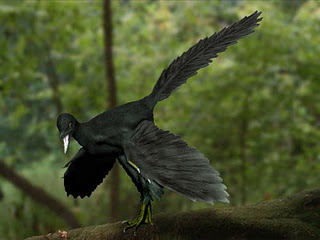We're open daily! View holiday hours
Science News
Archaeopteryx in Color
January 24, 2012

Archaeopteryx has puzzled scientists for over 150 years. A single, 150-million-year-old fossilized Archaeopteryx feather was discovered in a limestone deposit in Germany in 1861. Since then—and as a few more fossils have turned up—paleontologists have put the dinosaur-bird at the base of the avian evolutionary tree. The traits that make Archaeopteryx an evolutionary intermediate between dinosaurs and birds include the combination of reptilian features (teeth, clawed fingers and a bony tail) and avian features (feathered wings and a wishbone).
A team of scientists, led by Ryan M. Carney at Brown University, have now taken that first Archaeopteryx fossil and analyzed the famous dinosaur-bird’s color and flight abilities.
A few years ago, some of the same scientists found a way to determine the color of feathered dinosaurs by looking at melansomes in fossils. As Carl Zimmer describes in his Discover blog:
Depending on the size, shape, and spacing of melanosomes, they can produce a range of hues. It turns out that melanosomes are incredibly rugged, sometimes enduring for millions of years.
(Science in Action covered this research here.)
Placing the fossil in a powerful type of scanning electron microscope, Carney and his colleagues measured the length and width of the Archaeopteryx’s sausage-shaped melanosomes, roughly 1 micron long and 250 nanometers wide. To determine the melanosomes’ color, the team compared the Archaeopteryx melanosomes with those found in 87 species of living birds, representing four classes: black, gray, brown, and a type found in penguins. “What we found was that the feather was predicted to be black with 95 percent certainty,” Carney says.
Next, the team sought to define the melanosomes’ structure with greater accuracy. For that, they examined the fossilized barbules—tiny, rib-like appendages that overlap and interlock like zippers to give a feather rigidity and strength. The barbules and the alignment of melanosomes within them, Carney said, are identical to those found in modern birds.
“If Archaeopteryx was flapping or gliding, the presence of melanosomes would have given the feathers additional structural support,” explains Carney. “This would have been advantageous during this early evolutionary stage of dinosaur flight… We can’t say it’s proof that Archaeopteryx was a flier. But what we can say is that in modern bird feathers, these melanosomes provide additional strength and resistance to abrasion from flight, which is why wing feathers and their tips are the most likely areas to be pigmented.”
The research was published today in Nature Communication.
Illustration: NobuTamura